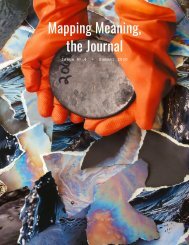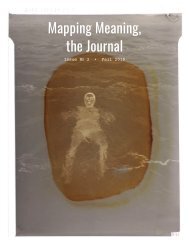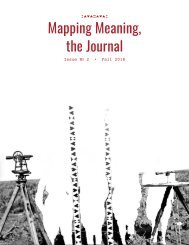Mapping Meaning, the Journal (Issue No. 1)
Create successful ePaper yourself
Turn your PDF publications into a flip-book with our unique Google optimized e-Paper software.
In Conversation with Consciousness<br />
Weston G. W. Wood<br />
Within this framework voice can <strong>the</strong>refore<br />
be understood as our relationality in<br />
action. Mladen Dolar’s psychoanalytical<br />
<strong>the</strong>ory of <strong>the</strong> voice in A Voice and <strong>No</strong>thing<br />
More demonstrates voice as essential to<br />
<strong>the</strong> thinking self. He argues that voice<br />
“can perhaps also be seen as <strong>the</strong> lever<br />
of thought” instead of <strong>the</strong> “vehicle of<br />
meaning” or “fetish object” (2006, pp.<br />
4-11)...and that voice can be better<br />
understood as an enabler of thought,<br />
bound with thought, or even being<br />
thought itself (Dolar, 2006, pp. 1-11). Dolar<br />
also discusses <strong>the</strong> voice as inherently a call<br />
to <strong>the</strong> o<strong>the</strong>r at length throughout his book<br />
(2006). Therefore, “voice” or vocalization<br />
is information at points of interaction and<br />
transformation between various human<br />
and more-than-human “systems,” whe<strong>the</strong>r<br />
<strong>the</strong>y be orcas or old-growth stands of oak<br />
(Wood, 2017, 8).<br />
David Abram’s deep ecology lends insight<br />
into what conversations are always<br />
occurring and what voices may be better<br />
heard. The phenomenology Abrams<br />
grounds in ecology reveals that we are<br />
beings perpetually perceiving <strong>the</strong> larger<br />
world around us in an active, dynamic<br />
process that shapes both perceiver and<br />
perceived. (Abram, 1996, p. 31-72). This<br />
occurs within “fields of flesh” from which<br />
we can never truly remove ourselves to<br />
an impartial objectivity – we are always<br />
already interacting with our environments<br />
(Abram, 1996, p. 66). One crucial insight<br />
is that language itself is material, of <strong>the</strong><br />
“flesh,” arising out of “living speech” that<br />
originated spontaneously in conversation<br />
with <strong>the</strong> living field. (73-92). Reciprocal<br />
perception occurs through vocalizations,<br />
both narrowly and broadly defined.<br />
Additionally, many in <strong>the</strong> industrialized<br />
world have lost <strong>the</strong> ability to “speak to”<br />
<strong>the</strong> larger biosphere and instead speak<br />
merely “about” it (Abram, 1996, p. 22). Like<br />
Bateson, Abram points out that very real<br />
maladies of health have been a function<br />
of imbalance with <strong>the</strong> more-than-human<br />
world in a multitude of cultures, and<br />
<strong>the</strong>y have been cured by restoring this<br />
balance (Abram, 1996, p. 22). This idea<br />
invites exploration as to how our modern<br />
voices remain ecological processes and<br />
what nonhuman voices are waiting to be<br />
engaged in a very material, “real” sensory<br />
experience, and how <strong>the</strong>se relationships<br />
might play into our mental health.<br />
This background framed <strong>the</strong> metalogues<br />
I conducted in which I attempted to<br />
trace <strong>the</strong> voices that function as points<br />
of conversational contact between self,<br />
human and more-than-human o<strong>the</strong>rs and<br />
demonstrate how we exist systemically. I<br />
hoped it would prove useful for folks who<br />
live under dominant assumptions about <strong>the</strong><br />
self as primarily individual and <strong>the</strong> merit<br />
of personal gain over community, when<br />
our own evolutionary history and ecology<br />
suggests <strong>the</strong> opposite to be far healthier.<br />
Bateson defines metalogue as “a<br />
conversation about some problematic<br />
subject…[in which] not only do <strong>the</strong><br />
participants discuss <strong>the</strong> problem but <strong>the</strong><br />
structure of <strong>the</strong> conversation as a whole<br />
<strong>Issue</strong> N o 1<br />
77







